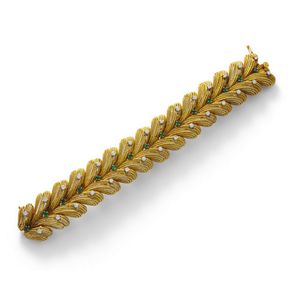Triomphe Emerald and Diamond Bracelet
La Triomphe emerald and diamond bombe bracelet, circa 1960, the 25 mm wide strap is composed of a line of rope twist chevron links, decorated at intervals with 30 claw-set brilliant-cut diamonds and 15 circular-cut emeralds, completed by a concealed box clasp, the diamonds together weighing approximately 1.80 carats, mounted in 18ct gold, gross weight 83.70 grams, length 170 mm, maker's mark for Astoria jewelry Manufacturing Company, long Island, New York.
You must be a subscriber, and be logged in to view price and dealer details.
Subscribe Now to view actual auction price for this item
When you subscribe, you have the option of setting the currency in which to display prices to $Au, $US, $NZ or Stg.
This item has been sold, and the description, image and price are for reference purposes only.
- Emeralds - Emeralds have been used in jewellery making for thousands of years, and are prized for their deep green colour, which is caused by the presence of chromium and vanadium in the mineral beryl. Because of their rare colour, emeralds are often more valuable than diamonds of a similar size and quality. In jewellery making, emeralds are typically cut into round or oval shapes to maximize their color and clarity. They are often set in gold or platinum and used as the centrepiece of a piece of jewellery, such as a ring or necklace. They can also be used in combination with other gems, such as diamonds, to create intricate and beautiful designs.
- Chevron Motif - In jewellery, a chevron is a V-shaped pattern or design that is often used to create a bold and striking visual effect, and as a symbol of strength, power and protection.. It is a classic motif used in many different styles of jewellery and can be seen in various forms such as on a ring, earrings, bracelets, and necklaces. It can be created with precious or semi-precious stones, pearls, or enamel. It can be found in different forms such as engraved or inlaid or beaded.
In ceramics the pattern is often used in decorative pottery and porcelain pieces, such as vases, bowls, plates and figurines. The chevron pattern can be created by using different colored glazes or by hand-painting the design onto the piece. It is also commonly found in the form of embossing or intaglio in decorative ceramic objects. This pattern can be seen as a popular design choice in Art Deco and Art Nouveau style of ceramics.
This chevron pattern can also be found in many different types of furniture, such as tables, chairs, chests of drawers, and cabinets. A common place to find chevron pattern is in a herringbone pattern, which is made up of repeating V-shaped patterns. The chevron pattern can be created by using different types of wood, inlaying or by using different colors of stain. It is also commonly found in the form of a veneer. This pattern can be seen as a popular design choice in mid-century modern, Art Deco, and contemporary style furniture. - Claw Set Jewellery - The description "claw set" in jewellery refers to a setting where the gemstone is held in place by metal prongs that resemble claws. These prongs are bent over the edges of the gemstone to secure it in the setting. This type of setting is commonly used for diamonds and other precious stones.
- Bombe Design in Jewellery - In the early 18th century, during the reign of Louis XIV, French court jewellers developed a new style of jewellery called "bombé" because of its bulging, curved shape.
The bombe design can be found in various styles of jewellery, from Georgian, Victorian, Art nouveau, to Art Deco and Retro eras, with the materials and techniques reflecting the era the jewellery was made.
The design is used for rings, bracelets, necklaces and earrings, where a curved or rounded shape is emphasized, giving an organic look to the piece, with the piece often made of gold and set with precious stones, such as diamonds, rubies, emeralds, and sapphires. The bombe design was also paired with other design elements such as engraving, enamelling, or gemstones - Circa - A Latin term meaning 'about', often used in the antique trade to give an approximate date for the piece, usually considered to be five years on either side of the circa year. Thus, circa 1900 means the piece was made about 1900, probably between 1895 and 1905. The expression is sometimes abbreviated to c.1900.
This item has been included into following indexes:
- bracelets and bangles - bombe design 26
-
bracelets, gold link type
- gold chevron link 10
- gold link of various types 1,955
- gold rope link 144
- bracelets, with diamonds - diamond and emeralds 163
- La Triomphe (Astoria Jewelry Mfg. Co.) (New York) - jewellery 6
